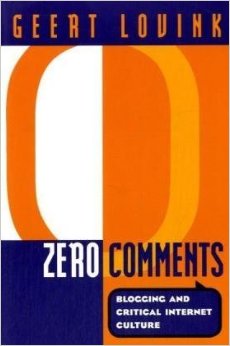Geert Lovink: Zero Comments: Kernels of Critical Internet Culture (2007)
Filed under book | Tags: · blogging, collaboration, distributed aesthetics, internet, internet culture, media theory, net criticism, networks, web 2.0

In Zero Comments Geert Lovink upgrades worn-out concepts and inquires the latest Web 2.0 hype around blogs, wikis and social network sites. In this third volume of his studies into critical Internet culture, Lovink develops a ‘general theory of blogging.’ Unlike most publications he is not focusing on the dynamics between bloggers and the mainstream news media. Instead of celebrating ‘citizen journalism’ blogs are analyzed in their ‘nihilist impulse’ to empty out established meaning structures. Blogs bring on decay of the 20th century broadcast media, and are proud of their in-crowd aspect in which linking, tagging and ranking have become the main drivers. The book also deals with the silent globalization of the Net in which no longer the West, but countries like India, China and Brazil are becoming main players in new media culture. It is not only the latest that Internet enthusiasts should focus on. Zero Comments upgrades concepts such as global Internet time, tactical media, the crisis of new media arts and the problematic relationship between architecture and the Net. The book ends with speculative notions on concepts such as organized networks, free cooperation and distributed aesthetics.
Publisher Routledge, 2007
ISBN 0415973155, 9780415973151
312 pages
Harold Abelson, Ken Ledeen, Harry Lewis: Blown to Bits: Your Life, Liberty, and Happiness After the Digital Explosion (2008)
Filed under book | Tags: · control society, privacy, surveillance, web 2.0
“Wherever you go…whatever you say, write, photograph, or buy…whatever prescriptions you take, or ATM withdrawals you make…you are generating information. That information can be captured, digitized, retrieved, and copied –anywhere on Earth, instantly. Sophisticated computers can increasingly uncover meaning in those digital traces–understanding, anticipating, and influencingyou as never before.
Is this utopia? Or the dawning of a 1984/Brave New World horror world? Whatever you call it, it’s happening. What kind of world are we creating? What will it be like to live there? Blown to Bits offers powerful and controversial answers to these questions–and give you the knowledge you need to help shape your own digital future, not let others do it for you. Building on their pioneering joint MIT/Harvard course, the authors reveal how the digital revolution is changing everything, in ways that are stunning even the most informed experts.
You’ll discover ten paradoxical truths about digital data–and learn how those truths are overturning centuries-old assumptions about privacy, identity, and personal control.
You’ll view the indelible digital footprints you’re making when you search Google…send emails and text messages…write Microsoft Word documents…download MP3s…make cellphone calls…post blog entries…pay highway tolls…use your supermarket discount card. And you’ll see how others could be following those footprints, in ways you never thought about, and might not like.
Writing in plain English, the authors illuminate the myriad implications of the digital revolution, answering the questions you’ve wondered about–or ought to wonder about. Who owns all that data about you? What do they owe you? How private is your medical information? Is it possible to send a truly secure message? Who can you trust for accurate information when traditional media is replaced by thousands of unfiltered Internet sources?
Along the way, they reveal the decisions governments and corporations are making right now that will shape your future…and show how to have your say in those decisions. Because you have an enormous stake in the outcome. We all do.”
Publisher Addison-Wesley, 2008
Creative Commons Attribution-Noncommercial-Share Alike 3.0 United States License
ISBN 0137135599, 9780137135592
366 pages
Book website
Interview (Democracy Now!, 2009)
Jonathan Zittrain: The Future of the Internet. And How to Stop It (2008)
Filed under book | Tags: · copyright, internet, netizens, networks, web 2.0

This extraordinary book explains the engine that has catapulted the Internet from backwater to ubiquity—and reveals that it is sputtering precisely because of its runaway success. With the unwitting help of its users, the generative Internet is on a path to a lockdown, ending its cycle of innovation—and facilitating unsettling new kinds of control.
IPods, iPhones, Xboxes, and TiVos represent the first wave of Internet-centered products that can’t be easily modified by anyone except their vendors or selected partners. These “tethered appliances” have already been used in remarkable but little-known ways: car GPS systems have been reconfigured at the demand of law enforcement to eavesdrop on the occupants at all times, and digital video recorders have been ordered to self-destruct thanks to a lawsuit against the manufacturer thousands of miles away. New Web 2.0 platforms like Google mash-ups and Facebook are rightly touted—but their applications can be similarly monitored and eliminated from a central source. As tethered appliances and applications eclipse the PC, the very nature of the Internet—its “generativity,” or innovative character—is at risk.
The Internet’s current trajectory is one of lost opportunity. Its salvation, Zittrain argues, lies in the hands of its millions of users. Drawing on generative technologies like Wikipedia that have so far survived their own successes, this book shows how to develop new technologies and social structures that allow users to work creatively and collaboratively, participate in solutions, and become true “netizens.”
Published by: Yale University Press, 2008
Creative Commons Attribution Non-Commercial Share-Alike 3.0 license
ISBN 0300124872, 9780300124873
352 pages
PDF (updated on 2013-6-5)
Comment (1)
